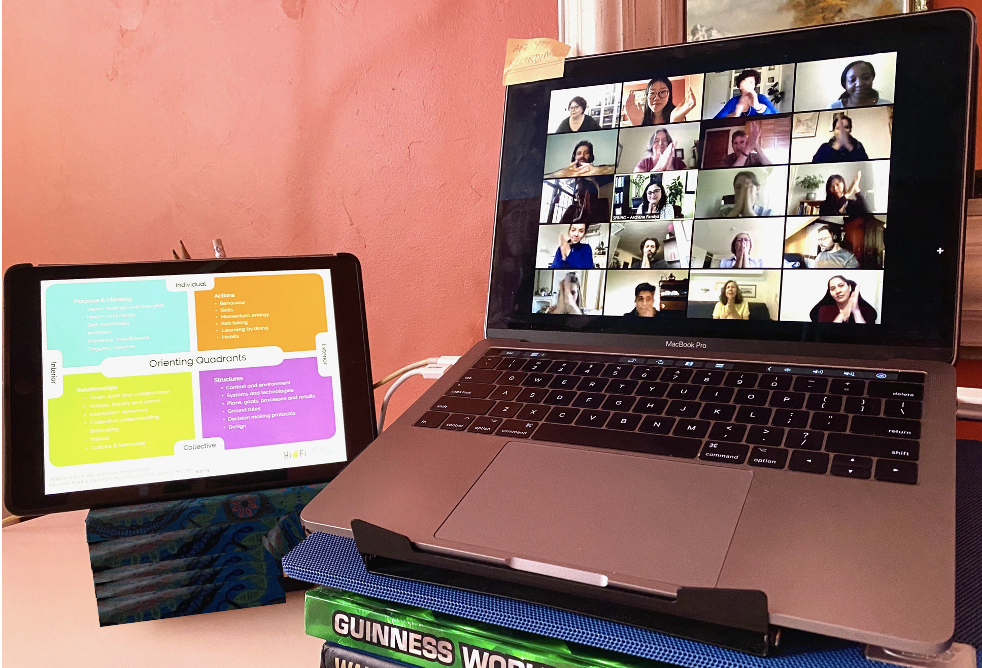Making Impact Virtually: Managing Perspectives in Online Meetings

Many believe that we have to live with the compromises of virtual meetings, and work around them, accepting some losses in purpose and urgency. In short, we should just expect less.
But we can’t afford to expect less. Our work for justice and the planet is far too important.
At Spring, we took up the challenge of creating meaningful and impactful virtual meetings.
Our collaboration programs have been popular resources to develop leading edge facilitation skills. Powerful conversations are an essential part of making impactful change and we believe there should be no compromise if they happen virtually.
One approach we have worked on involves recognizing the power of multiple viewpoints. Facilitators should appreciate the value of different perspectives and the energy they provide within a group. We like to work with the dance amongst four distinct quadrant perspectives, aligned with the principles of Integral Coaching® and the work of Ken Wilber.
The frame of the quadrant perspectives is this: each person has a distinct quadrant from which they see and relate to life and their work. This is like a ‘home base’ and a person accesses it when they want to understand something. No one perspective is better than the other. When a leader accommodates all four quadrant perspectives, the meeting becomes more inclusive and allows each participant to contribute more fully. When all of these perspectives are present in a conversation, there are multiple dimensions of reality. By acknowledging the validity of all perspectives, a more comprehensive approach to complex problem solving can occur and the participants recognize their work as part of the solution.

We’ve worked on ways to acknowledge each of the quadrant perspectives in a virtual meeting forum. There are a number of tools and processes offered by most platforms, and with creative, thoughtful meeting planning, a facilitator can create a virtual meeting that maximizes inclusion for participants from all of the four domains, the invisible diversity in a group.
Participants Orienting from the ‘Purpose and Meaning’ Quadrant
For those orienting from this quadrant, it’s important to be assured that the direction of the meeting aligns to an understood purpose and meaning. If the meeting’s purpose goals and desired outcomes aren’t clear upfront, the meeting may feel overly constructed and disengaging.
Ways of Working:
- Start the conversation inviting people to share what they are thinking.
- Take time to talk about the purpose of the meeting and align on its expression.
- Ask powerful, specific questions to participants.
- Use creative tools, like mood boards, to co-create new ideas and purposeful solutions.
Participants Orienting from the ‘Action’ Quadrant
For those with a preference for action, virtual meetings can have the potential to feel stagnating. These participants rely on their somatic energy or ‘room presence’ in a group to keep things moving. However, in a virtual room somatic energy doesn’t transmit the same way. Watching someone speak non-stop for several minutes feels tiring and leaders that rely on more of a teaching style will feel and be less effective. Meetings that include practical exercises and learning by doing can become more inclusive and more detailed in a virtual space.
Ways of Working:
- Keep energy going with a well-planned agenda: avoid energy-killing pauses with too many open-ended or general questions.
- Limit lecture-style presentations to 20 minutes.
- Gather answers and action points on virtual meeting tools: use virtual whiteboards.
- Workshop solutions in real time in smaller groups: use breakout rooms or fish bowls.
- Manage time-keeping with countdowns.
Participants Orienting from the ‘Relationships’ Quadrant
For these participants, a virtual room can be a vessel that allows for the type of relation long desired in live meetings. A well-structured virtual meeting can be an equalizer. It can close power distance because there is no ‘right’ table or seat to take: everyone takes up the same space.
Well-structured virtual meetings foster equal participation and can allow for expressions of individuality. Biases of proximity are taken away. There can be a richer experience of a team really being together.
Ways of Working:
- Get to know each other by encouraging sharing of experiences.
- Create community with co-creative projects on communal whiteboards.
- Create more intimacy in 5-minute break-out sessions: quick shares of 3 people.
- Create longer team exercises with small teams of no more than 6 people.
- Leaders can draw out introverts by calling on them.
Participants Orienting from the ‘Structures’ Quadrant
Some may think that virtual meetings only support a conversation of talking heads. But a well-designed virtual meeting can make working more efficient: an opportunity to build a process, review milestones and bring greater rigour to the task of developing a process or system.
Virtual space tends to be less spontaneous: technology manages time better than humans. Because everyone has the same tools (and hopefully access to the same technology), everyone has the same ability to contribute. Participant inputs can be systemized and managed well. Progress charts and scorecards can be easily reviewed, and updates can be gathered and noted for all to see easily.
Ways of Working:
- The work flow can follow a precise agenda, managed by the host.
- Using only one shared screen at a time ensuring focus on the task on the agenda.
- Project management charts can be reviewed and updated as a team.
- Virtual tools allow participants to see multiple inputs, prioritize them, and assign value.
- Agendas are shared in advance and sessions are prepared to the minute.
The pandemic has shown that with access to the right technology many of the meeting and conferences once requiring in-person attendance are actually possible virtually. We should see this as an on-going opportunity: not only to reduce the world’s carbon footprint, but also to experience what virtual meetings uniquely make possible.
We will continue to adapt to the new normal, and some of our newest lessons may inform an even better, more collaborative future. And finally, in-person meetings might change forever as well: as they are becoming more rare and special, we might just be motivated to not waste a minute of it.
Tags:
CollaborationJune 19, 2020

